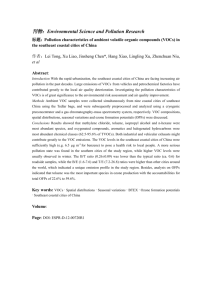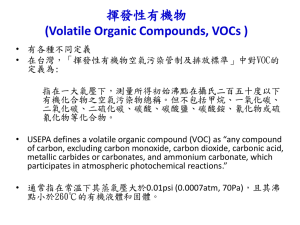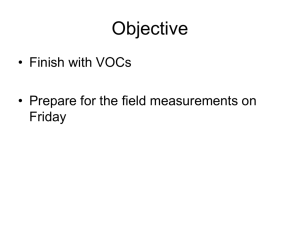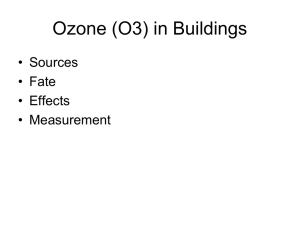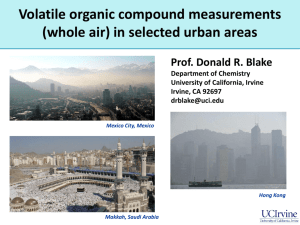General Considerations in VOC Sensing
advertisement
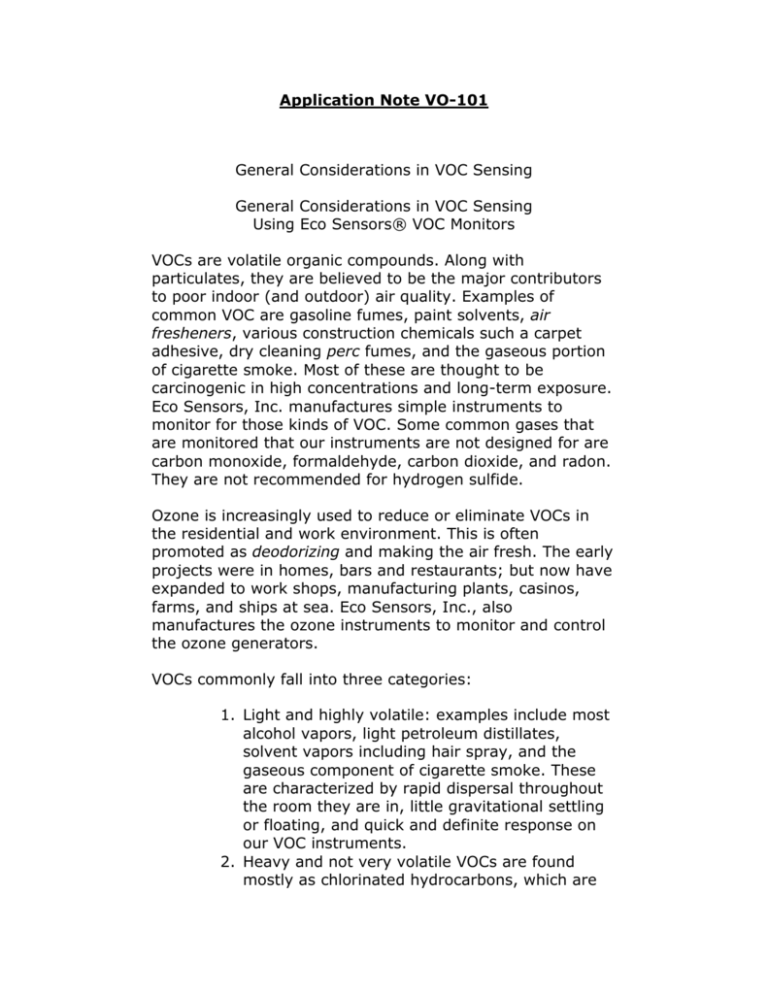
Application Note VO-101 General Considerations in VOC Sensing General Considerations in VOC Sensing Using Eco Sensors® VOC Monitors VOCs are volatile organic compounds. Along with particulates, they are believed to be the major contributors to poor indoor (and outdoor) air quality. Examples of common VOC are gasoline fumes, paint solvents, air fresheners, various construction chemicals such a carpet adhesive, dry cleaning perc fumes, and the gaseous portion of cigarette smoke. Most of these are thought to be carcinogenic in high concentrations and long-term exposure. Eco Sensors, Inc. manufactures simple instruments to monitor for those kinds of VOC. Some common gases that are monitored that our instruments are not designed for are carbon monoxide, formaldehyde, carbon dioxide, and radon. They are not recommended for hydrogen sulfide. Ozone is increasingly used to reduce or eliminate VOCs in the residential and work environment. This is often promoted as deodorizing and making the air fresh. The early projects were in homes, bars and restaurants; but now have expanded to work shops, manufacturing plants, casinos, farms, and ships at sea. Eco Sensors, Inc., also manufactures the ozone instruments to monitor and control the ozone generators. VOCs commonly fall into three categories: 1. Light and highly volatile: examples include most alcohol vapors, light petroleum distillates, solvent vapors including hair spray, and the gaseous component of cigarette smoke. These are characterized by rapid dispersal throughout the room they are in, little gravitational settling or floating, and quick and definite response on our VOC instruments. 2. Heavy and not very volatile VOCs are found mostly as chlorinated hydrocarbons, which are generally used as commercial solvents: perchloroethylene (perc dry cleaning fluid), methylene chloride, trichloroethylene, carbon tetrachloride and chloroform. If there is not much room air circulation these VOCs will tend not to disperse throughout the room, and instead will tend to keep in one area and sink to the floor or table top. They also tend to cling to fabrics such as curtains. This is important to know in terms of placement of the VOC monitors and ozonated air supply duct outlet locations. 3. VOCs mixed with particulates are usually the products of combustion where the particulates are the solid residue (carbon or ash). The color in cigarette smoke and Diesel fumes are particulate residues. The color density is not a reliable guide to the amount of VOCs present (often there is very little in thick, black Diesel fumes). Specialized instruments not made by Eco Sensors are used to analyze particulate concentrations, and ozone is not generally effective in reducing particulates. Where there are particulates in the air, ozone air treatment also includes ionizer and/or filter particulate removal equipment. There are of course many non-VOC pure particulate mixtures trapped by such equipment including dust and pollen. A common misconception is to equate smell level with VOC (or ozone levels. This is very misleading. Among VOCs, esters such as perfume and mercaptans such as hydrogen sulfide are easily detected at minimal concentrations. Carbon monoxide, some cooking gases, and some alcohol vapors cannot be detected at all unless they are doped with odor agents. The odor threshold for ozone (not a VOC but often mentioned here) varies widely by the observer with estimates ranging from thresholds of less than .05 ppm to over 1 ppm. The Eco Sensor C-21 instrument is widely used to monitor these VOCs. It is very good at early warning in semiquantitative terms, and for follow-up leak tracking, but it is not designed or sold as a specific gas analyzer. Care should be observed when compounds of nitrogen are involved such as NOx, urea and ammonia. These are not VOCs. Under certain conditions they can be converted to nitric acid. Both Nitric acid fumes and NOx look like ozone to many ozone instruments including those of Eco Sensors. Sulfuric acid can be a product of hydrogen sulfide and water. In general, acid gases are a problem element to be guarded against for systems of air treatment and ozone and VOC monitoring. To see a brochure on the Eco Sensor VOC Monitoring Instrument Model C-21, click here.
